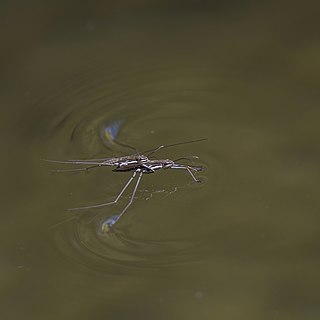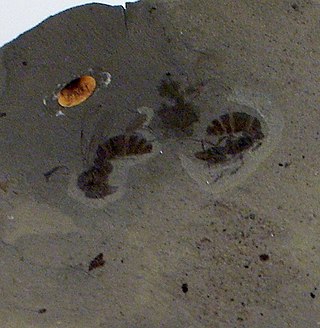
A crane fly is any member of the dipteran superfamily Tipuloidea, which contains the living families Cylindrotomidae, Limoniidae, Pediciidae and Tipulidae, as well as several extinct families. "Winter crane flies", members of the family Trichoceridae, are sufficiently different from the typical crane flies of Tipuloidea to be excluded from the superfamily Tipuloidea, and are placed as their sister group within Tipulomorpha.

The Pentatomoidea are a superfamily of insects in the Heteroptera suborder of the Hemiptera order. As Hemiptera, they share a common arrangement of sucking mouthparts. The roughly 7000 species under Pentatomoidea are divided into 21 families. Among these are the stink bugs and shield bugs, jewel bugs, giant shield bugs, and burrower bugs.

Horse-flies and deer flies are true flies in the family Tabanidae in the insect order Diptera. The adults are often large and agile in flight. Only female horseflies bite land vertebrates, including humans, to obtain blood. They prefer to fly in sunlight, avoiding dark and shady areas, and are inactive at night. They are found all over the world except for some islands and the polar regions. Both horse-flies and botflies (Oestridae) are sometimes referred to as gadflies.

The Gerridae are a family of insects in the order Hemiptera, commonly known as water striders, water skeeters, water scooters, water bugs, pond skaters, water skippers, water gliders, water skimmers or puddle flies. Consistent with the classification of the Gerridae as true bugs, gerrids have mouthparts evolved for piercing and sucking, and distinguish themselves by having the unusual ability to walk on water, making them pleuston (surface-living) animals. They are anatomically built to transfer their weight to be able to run on top of the water's surface. As a result, one could likely find water striders present in any pond, river, or lake. Over 1,700 species of gerrids have been described, 10% of them being marine.

Veliidae is a family of gregarious predatory insects in the suborder Heteroptera. They are commonly known as riffle bugs, small water striders, or broad-shouldered water striders because the segment immediately behind the head is wider than the rest of the abdomen. The genus Rhagovelia is also referred to as a ripple bug.

Nepidae is a family of exclusively aquatic Heteropteran insects in the order Hemiptera. They are commonly called water scorpions for their superficial resemblance to scorpions, due to their raptorial forelegs and the presence of a long slender process at the posterior end of the abdomen, resembling a tail. There are 14 genera in the family, in two subfamilies, Nepinae and Ranatrinae. Members of the genus Ranatra, the most widespread and species-rich genus, are sometimes called needle bugs or water stick insects as they are slenderer than Nepa.
The arthropod leg is a form of jointed appendage of arthropods, usually used for walking. Many of the terms used for arthropod leg segments are of Latin origin, and may be confused with terms for bones: coxa, trochanter, femur, tibia, tarsus, ischium, metatarsus, carpus, dactylus, patella.

The Lygaeidae are a family in the Hemiptera, with more than 110 genera in four subfamilies. The family is commonly referred to as seed bugs, and less commonly, milkweed bugs, or ground bugs. However, while many of the species feed on seeds, some feed on sap (mucivory) or seed pods, others are omnivores and a few, such as the wekiu bug, are carnivores that feed exclusively on insects. Insects in this family are distributed across the world. The family was vastly larger, but numerous former subfamilies have been removed and given independent family status, including the Artheneidae, Blissidae, Cryptorhamphidae, Cymidae, Geocoridae, Heterogastridae, Ninidae, Oxycarenidae and Rhyparochromidae, which together constituted well over half of the former family.

Hydrometridae is a family of semiaquatic insects, known as marsh treaders or water measurers. They have a characteristic elongated head and body which makes them resemble a yardstick for measuring the water surface.

Tetrigidae is an ancient family in the order Orthoptera, which also includes similar families such as crickets, grasshoppers, and their allies. Species within the Tetrigidae are variously called groundhoppers, pygmy grasshoppers, pygmy devils or "grouse locusts".

Pleidae, the pygmy backswimmers, is a family of aquatic insects in the order Hemiptera. There are 37 species in three genera, distributed across most of the world, except the polar regions and remote oceanic islands.

Water treaders, the superfamily Mesovelioidea, are insects in the order Hemiptera, the true bugs. They are semiaquatic insects that live in moist and wet habitat and on wet plant matter in several types of aquatic habitat.

Ypresiomyrma is an extinct genus of ants in the subfamily Myrmeciinae that was described in 2006. There are four species described; one species is from the Isle of Fur in Denmark, two are from the McAbee Fossil Beds in British Columbia, Canada, and the fourth from the Bol’shaya Svetlovodnaya fossil site in Russia. The queens of this genus are large, the mandibles are elongated and the eyes are well developed; a stinger is also present. The behaviour of these ants would have been similar to that of extant Myrmeciinae ants, such as solitary foraging for arthropod prey and never leaving pheromone trails. The alates were poor flyers due to their size, and birds and animals most likely preyed on these ants. Ypresiomyrma is not assigned to any tribe, and is instead generally regarded as incertae sedis within Myrmeciinae. However, some authors believe Ypresiomyrma should be assigned as incertae sedis within Formicidae.

Gerroidea is a superfamily of semiaquatic bugs in the order Hemiptera. There are at least 3 families and more than 2,000 described species in Gerroidea.

Notonecta undulata, also known by the common name grousewinged backswimmer, are from the family Notonectidae and the insect suborder Heteroptera. They are a type of hemipteran or true bug. These aquatic insects typically spend their time at the water's surface, using their abdomen and legs to cling to the underside of the surface tension. The Grousewinged backswimmer can be found in both lotic and lentic environments; however, they typically prefer small ponds and lakes where the water is slow-moving with less current. They swim upside down looking for prey. Once they stop swimming they float back up to the surface. These insects can be distinguished from water boatman or Corixidae by their segmented beak and front legs. Water boatman have highly modified front legs whereas backswimmers do not. Backswimmers are distributed across a broad range throughout North America. However, the species Notonecta undulata has only been documented and studied in southern Manitoba, Saskatchewan, Alberta and the western United States. N. undulata differs from other backswimmers by their antennae and size. They are approximately 10–12 mm long, and their antennae are 4 segmented.

Hebrus is a genus of velvet water bugs in the family Hebridae. There are at least 160 described species in Hebrus.
Rhagovelia choreutes is a species in the infraorder Gerromorpha, in the order Hemiptera . The distribution range of Rhagovelia choreutes includes Central America and North America.

Merragata is a genus of velvet water bugs in the family Hebridae. There are about seven described species in Merragata.
Hebrus buenoi, or Bueno's velvet water bug, is a species of velvet water bug in the family Hebridae. It is found in Central America and North America.
Lipogomphus is a genus of velvet water bugs in the family Hebridae. There are at least four described species in Lipogomphus.
















